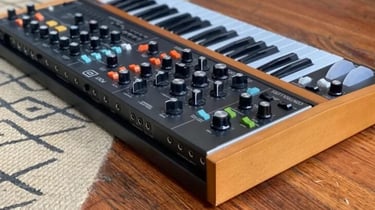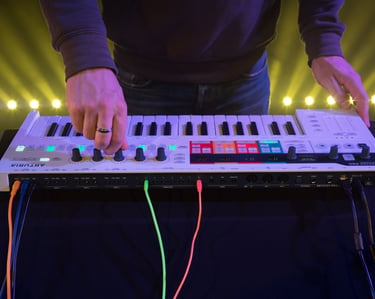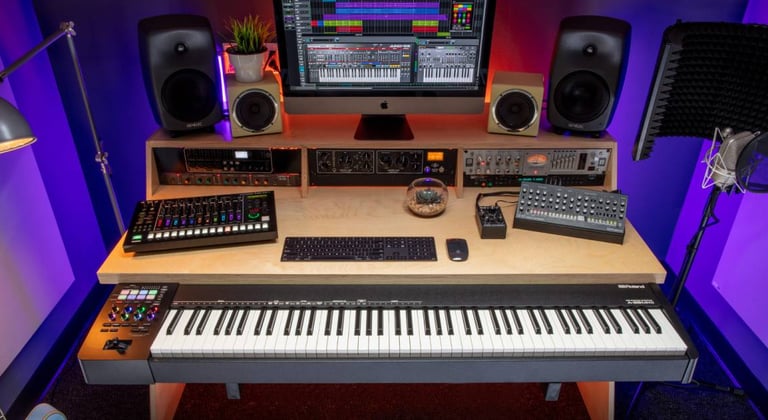
Exploring the World of MIDI Keyboards: Unlocking Creative Possibilities
Chasebeatz
7/8/2023
Introduction
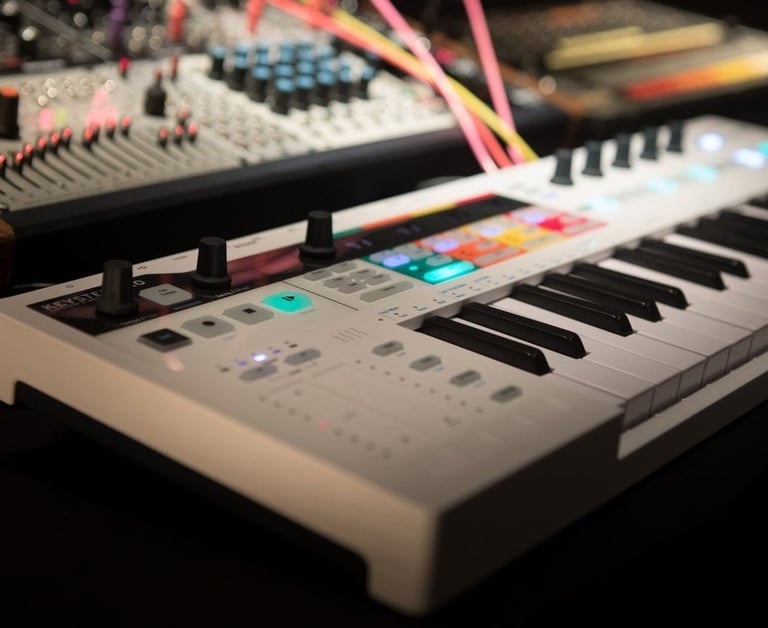

In the realm of music production, MIDI keyboards have become an essential tool for beginners and professionals alike.
Their versatility and ability to bridge the gap between musical ideas and the digital realm make them indispensable in the creative process.
In this thorough music production blog post, we will delve into what a MIDI keyboard is, why it is needed, its suitability for beginners, and how to use one for those just starting their musical journey.
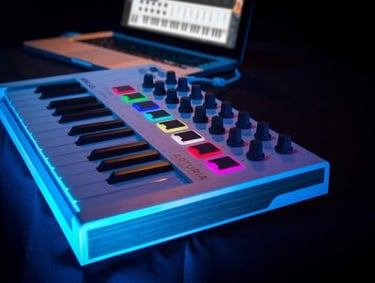

A MIDI keyboard serves as a powerful tool for music creation and production. It provides a tactile and expressive interface for playing virtual instruments, composing melodies, and programming rhythms.
By connecting the MIDI keyboard to a computer or music production setup, musicians can access an extensive range of sounds and control parameters in their preferred music software.
This opens up a world of possibilities for sound design, arrangement, and performance.
What is a MIDI Keyboard?
A MIDI keyboard is a musical instrument controller that allows musicians, producers, and composers to input musical data into a computer or other MIDI-compatible devices. It typically resembles a piano keyboard, with keys that can be played like a traditional piano.
However, unlike a traditional piano, a MIDI keyboard doesn't produce sound on its own. Instead, it sends MIDI (Musical Instrument Digital Interface) data, which consists of messages like note-on, note-off, and control change commands, to control and trigger sounds in software synthesizers, virtual instruments, or external MIDI sound modules.
MIDI keyboards offer a versatile and expressive way to create and perform music digitally, providing a bridge between the physical act of playing and the digital realm of music production.
Why is a MIDI Keyboard Needed?
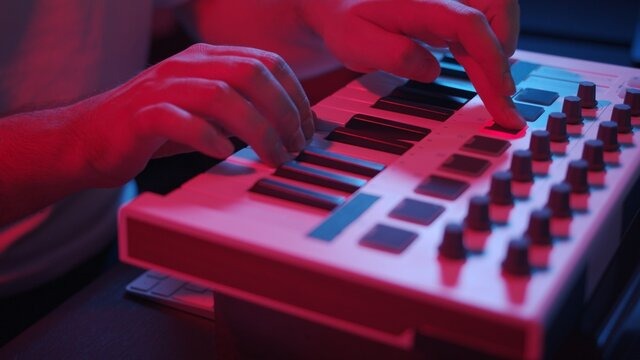

Suitability for Beginners:
MIDI keyboards are well-suited for beginners due to their intuitive nature and ease of use. They provide a tactile and visual representation of musical concepts, making it easier for beginners to understand and explore music theory.
MIDI keyboards also offer features such as guided learning modes and pre-mapped controls that facilitate the learning process.
Additionally, they can be used alongside tutorial videos and educational resources, allowing beginners to develop their skills at their own pace.
Reasons for Using MIDI Keyboards
Versatility: MIDI keyboards offer a wide range of sounds and instruments, allowing users to experiment with different genres and styles. From piano and strings to synthesizers and drums, the possibilities are virtually limitless.
Expressive Performance: MIDI keyboards enable musicians to add nuance and expression to their performances. The velocity-sensitive keys detect the force with which each key is pressed, allowing for dynamic playing and nuanced articulation.
Streamlined Workflow: MIDI keyboards enhance productivity by providing physical controls for adjusting parameters like volume, modulation, and effects in real-time. This hands-on approach allows for quicker and more intuitive music production.
Using a MIDI Keyboard for Beginners
Connection:
Start by connecting the MIDI keyboard to your computer or MIDI interface using a USB or MIDI cable.
Software Setup:
Install any necessary drivers or software provided by the manufacturer. Launch your preferred music software (Digital Audio Workstation) and configure the MIDI keyboard as the input device.
Playing Sounds:
Select a virtual instrument or sound in your music software and start playing the keys on your MIDI keyboard. Experiment with different sounds, melodies, and chord progressions to explore your creativity.
Recording and Editing:
Use your MIDI keyboard to record your performances into the music software's MIDI sequencer. You can then edit and refine your compositions, adjust note timings, and add additional layers of instrumentation.
how many kinds of midi keyboards are there?
Compact MIDI Keyboards:
These keyboards typically have 25, 32, or 37 keys and are designed to be portable and space-efficient. They are ideal for producers who prioritize mobility and want a MIDI controller they can easily take on the go.
Standard MIDI Keyboards:
Standard-sized MIDI keyboards usually come with 49, 61, or 76 keys. These keyboards offer a wider range for playing melodies, chords, and more complex musical arrangements. They strike a balance between portability and versatility.
Full-Size MIDI Keyboards:
Full-size MIDI keyboards have 88 keys, just like a traditional acoustic piano. They are suitable for pianists or those who want a keyboard that closely emulates the feel and range of an acoustic instrument. These keyboards are typically larger and less portable.
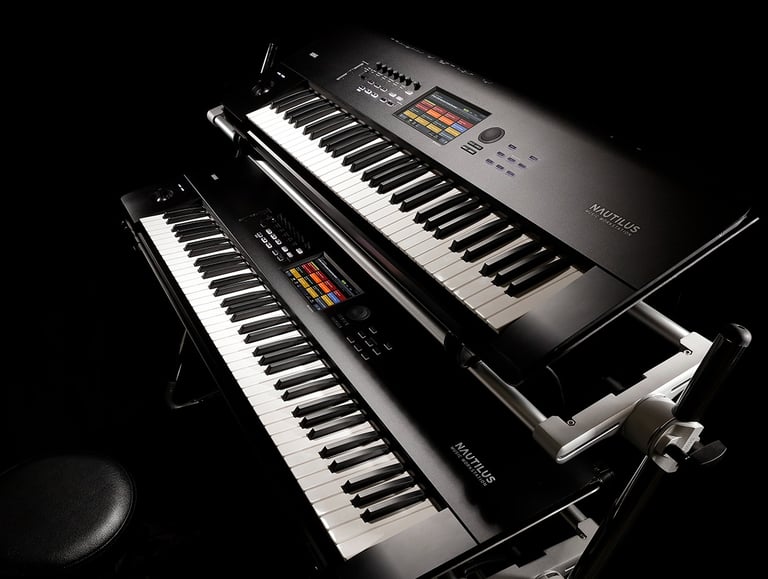

MIDI Keyboard Controllers:
These keyboards focus primarily on providing a range of controls and features for music production rather than a large number of keys.
They often have fewer than 49 keys but offer additional features like drum pads, knobs, faders, and transport controls. MIDI keyboard controllers are popular among electronic music producers and performers.
MIDI Keyboard Workstations:
Workstation keyboards combine the functionality of a MIDI keyboard with built-in sounds, effects, and sequencing capabilities.
They often feature a larger number of keys, advanced sound libraries, and comprehensive controls for music production and performance.
MIDI Keytars:
Keytars are MIDI keyboards designed to be worn like a guitar, allowing for expressive movement and performance on stage. They typically feature a compact keyboard, buttons, and controls mounted on a guitar-like body.
MIDI Keyboard Synthesizers:
These keyboards combine the functionality of a MIDI controller with built-in synthesizer engines. They allow for sound creation and manipulation directly from the keyboard itself, without the need for external software or hardware.
It's worth noting that MIDI keyboards can also vary in terms of key action, which refers to how the keys feel and respond to touch.
Key action can be categorized as weighted (simulating the feel of an acoustic piano), semi-weighted (a compromise between piano-like feel and ease of playing), or synth-action (lighter and springier keys, ideal for fast-paced electronic music).
Do you need a DAW for MIDI?
No, a Digital Audio Workstation (DAW) is not strictly required for using MIDI.
While a DAW provides a comprehensive environment for recording, editing, and producing music using MIDI, you can still use a standalone MIDI controller with software synthesizers, virtual instruments, or hardware sound modules that support MIDI connectivity.
However, a DAW offers more extensive features and flexibility for MIDI-based music production.
Is 49 keys enough?
The number of keys on a MIDI keyboard depends on personal preference and the type of music you plan to create. For many producers and musicians, a 49-key MIDI keyboard is sufficient for most musical arrangements and compositions.
It provides a good balance between portability and playing range. However, if you frequently work with complex chord progressions, intricate melodies, or play piano-based music, you may prefer a larger keyboard with 61 keys or even a full-size 88-key keyboard.
Can you use a normal piano as MIDI?
Yes, you can use a traditional acoustic or digital piano as a MIDI controller.
By connecting the MIDI output of the piano to a MIDI interface or a computer with MIDI input capabilities, you can use the piano to transmit MIDI data, triggering virtual instruments or controlling external MIDI devices.
This allows you to harness the expressive qualities of a piano while benefiting from the versatility of MIDI.
Do you need an 88-key keyboard?
Whether you need an 88-key keyboard depends on your specific requirements and playing style. An 88-key keyboard closely emulates the size and range of a traditional acoustic piano, making it ideal for pianists or those who desire a wide playing range.
However, it is not necessary for all types of music production. If you primarily work with electronic music, synthesizers, or focus on melodies rather than complex piano arrangements, a smaller keyboard with fewer keys may suffice.
How many channels can MIDI have?
MIDI supports 16 channels, numbered from 1 to 16.
Each MIDI channel can carry separate MIDI data, allowing for simultaneous control and playback of different instruments or sound sources. This channel-based system enables the separation and control of multiple MIDI devices within a MIDI setup.
How many pins is MIDI?
MIDI connectors use 5-pin DIN connectors.
The standard MIDI cable has a 5-pin DIN connector on each end, consisting of three pins for MIDI data transmission (two for signal and one for ground) and two additional pins for powering certain MIDI devices (optional).
Is MIDI better than audio?
MIDI and audio serve different purposes in music production. MIDI is a protocol used for transmitting musical data, such as note information, control changes, and timing.
It is highly versatile, allowing for precise control, editing, and manipulation of musical elements. Audio, on the other hand, represents the actual recorded or synthesized sound waveforms.
Both MIDI and audio are important components in music production, and they complement each other. MIDI provides flexibility and control during the creative process, while audio captures the final sound for playback and distribution.
What should I look for in a MIDI keyboard?
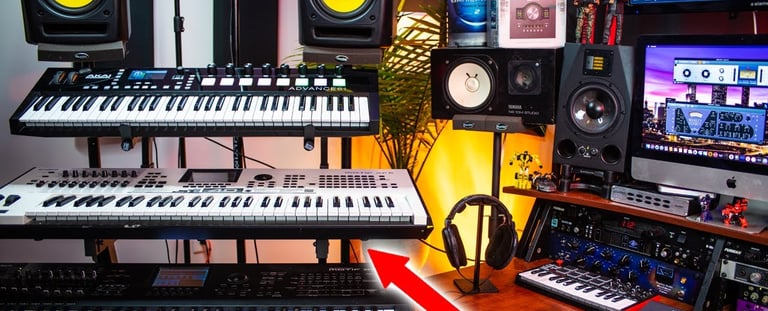

MIDI keyboards have taken the music production world by storm, igniting excitement and capturing the imagination of musicians and producers everywhere.
Their boundless versatility, sleek workflow, and mind-blowing creative potential have made them indispensable tools in the industry.
With seamless integration, these keyboards empower artists to effortlessly command a universe of virtual instruments and effects, unleashing their musical vision like never before.
MIDI's universal standard and constant innovation ensure an electrifying journey that fuels the passion and excitement of music makers worldwide. Get ready to soar to new heights of sonic expression with the exhilarating power of MIDI keyboards!
Versatility: MIDI keyboards provide a vast range of sounds and instruments.
You can access virtual instruments, software synthesizers, and sample libraries, allowing you to explore various musical genres and styles.
Expressiveness: MIDI keyboards capture the nuances of your playing, including velocity sensitivity and aftertouch. This allows for dynamic and expressive performances, adding depth and emotion to your music.
Workflow Efficiency: MIDI keyboards streamline the music production process. They provide physical controls, such as knobs, faders, and drum pads, which allow for real-time manipulation of parameters, making it easier to shape sounds and create dynamic performances.
Editing and Flexibility: MIDI data is editable and non-destructive. You can easily modify note timings, velocities, and other musical elements after recording. This flexibility enables precise editing and arrangement of musical parts.
Integration and Compatibility: MIDI keyboards seamlessly integrate with popular music software and Digital Audio Workstations (DAWs), enabling intuitive control and mapping. They are compatible with a wide range of devices, ensuring compatibility and interoperability.
Learning and Education: MIDI keyboards facilitate the learning process, as they provide a visual representation of musical concepts. They can be used in conjunction with tutorials, educational resources, and interactive learning software to aid in music theory understanding and skill development.
Pros:
Cons:
Lack of Acoustic Sound: MIDI keyboards don't produce sound on their own. They rely on external devices or software to generate audio. This means that you need a computer, software synthesizers, or other sound modules to hear the sounds produced by the MIDI keyboard.
Initial Setup and Learning Curve: Setting up MIDI keyboards, configuring software, and mapping controls may require some initial effort and technical knowledge. Additionally, learning to use MIDI effectively and exploring all its possibilities may take time and practice.
Dependency on Technology: MIDI keyboards rely on proper functioning of MIDI connections, software compatibility, and stable computer systems. Technical issues such as latency, software conflicts, or hardware malfunctions can occasionally affect the user experience.
Limitations of Keyboards: MIDI keyboards typically have limited space and may not provide the same tactile experience as acoustic instruments. Keyboard players who are accustomed to the feel and response of traditional pianos may find it challenging to adjust to the differences in touch and key action.
Popularity and Continued Use:
When looking for a MIDI keyboard, several factors should be considered to ensure it meets your specific needs and preferences. Here are some key aspects to consider:
Number of Keys: Determine the number of keys you require based on your playing style and musical goals. Compact keyboards (25-37 keys) are portable but offer limited playing range, while standard-sized keyboards (49-76 keys) strike a balance between portability and versatility. Full-size keyboards (88 keys) closely resemble acoustic pianos but are larger and less portable.
Key Action: Choose a key action that suits your playing preference. Weighted keys simulate the feel of acoustic pianos, semi-weighted keys offer a compromise between piano-like feel and ease of playing, and synth-action keys are lighter and springier, ideal for fast-paced electronic music.
Controls and Features: Consider the additional controls and features offered by the MIDI keyboard. These can include drum pads, knobs, faders, transport controls, and assignable buttons. These features enhance workflow efficiency and allow for real-time control and customization of sounds.
Software Integration: Check the compatibility of the MIDI keyboard with your preferred Digital Audio Workstation (DAW) or music software. Ensure that the keyboard has native integration or can be easily mapped to your software for seamless control and efficient workflow.
Connectivity Options: Look for MIDI keyboards that offer versatile connectivity options. Most MIDI keyboards now come with USB connectivity, which allows for easy connection to computers and mobile devices. Some keyboards also offer traditional MIDI ports for connection to external sound modules and MIDI-enabled hardware.
Build Quality and Durability: Consider the build quality and durability of the MIDI keyboard. Look for keyboards with sturdy construction and quality materials that can withstand regular use.
Budget: Determine your budget and find a MIDI keyboard that offers the best value for your money within your price range. Consider the balance between features, quality, and affordability.
Conclusion:
In conclusion, MIDI keyboards are indispensable tools in the world of music production, providing a multitude of benefits for musicians, producers, and composers. With their versatility, MIDI keyboards offer access to a vast array of sounds, instruments, and effects, allowing for exploration and experimentation across various genres and styles.
The expressiveness of MIDI keyboards, with features like velocity sensitivity and aftertouch, adds depth and emotion to performances. Additionally, their physical controls enhance workflow efficiency, enabling real-time manipulation and customization of sounds. MIDI keyboards seamlessly integrate with software and hardware, providing compatibility and flexibility.
While they have limitations, such as reliance on external sound sources, MIDI keyboards remain powerful assets that empower musicians to unlock new levels of creativity and enhance their music production journey. Embrace the capabilities of MIDI keyboards and elevate your musical endeavors to new heights.
Thank you for joining us on this journey through the world of MIDI Keyboards
Stay Tuned for Daily Posts about Comprehensive reviews on every Gear from our selection reccomended by many artists from beginner to proffessional level.
Please note that some of the links provided in this content may be affiliate links. This means that if you make a purchase through those links, I may earn a commission at no additional cost to you.
Chase
full-time Music Producer with over 4 years of experience using Ableton Live D.A.W. Chase will help you develop your music production abilities with tutorials, challenges, and also home studio gear reviews.

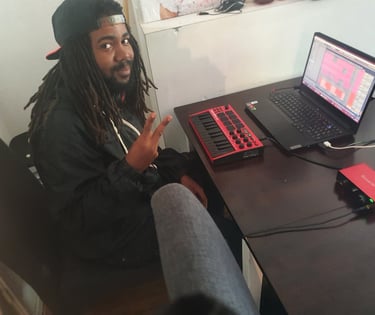
Get connected


ChaseBeatz is a budding music production business dedicated to crafting dynamic and engaging beats for emerging artists. With a focus on providing affordable and high-quality productions, ChaseBeatz helps aspiring musicians bring their creative visions to life, offering a solid foundation for their musical journey.

